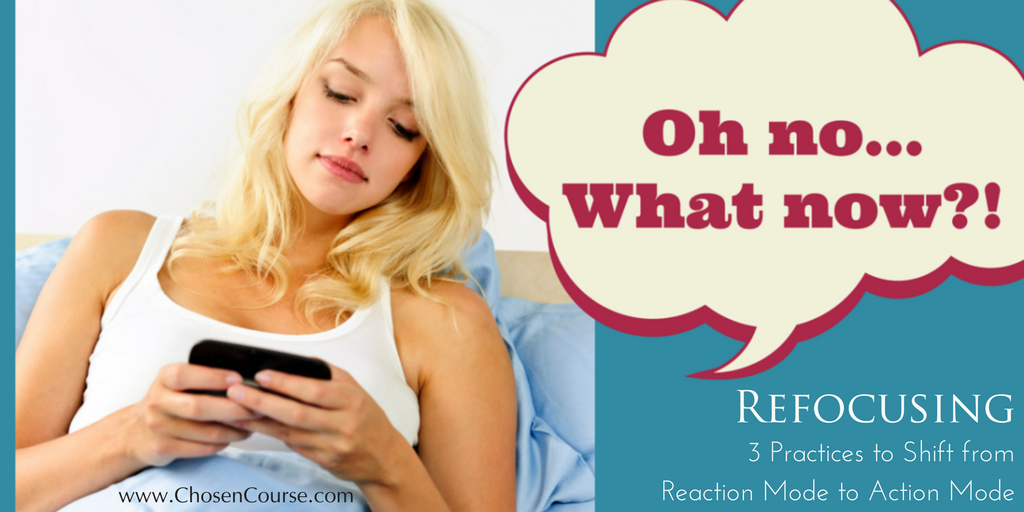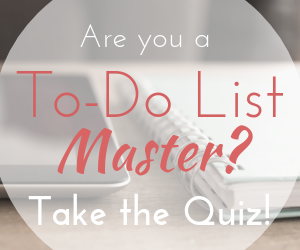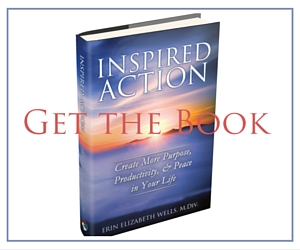Have you had one of those mornings when you roll over in bed, grab your smart phone to check your email, and then start with an immediate groan as you begin responding to all the new messages that came in over night?
Most of us have done it… myself included. You just started your day in reaction mode. Rather than being focused on the actions that you choose and which are most important to you, instead your day is beginning with responding to someone else’s agenda and needs. And, yes, the same thing often happens when your kids bounce into bed to wake you up first thing too… you begin your day in reaction mode.
The question becomes how can you reclaim your own agenda, control, and agency over your attention. How can you move back into action mode?
Action vs. Reaction- Why Reaction Mode is a Problem
Let’s start by clarifying the problem. When you’re in reaction mode then you spend the entire day putting out fires, responding to the urgent, and making other people’s agendas more important than your own. This experience leads to a sense of being out of control, a feeling of chaos, and the virtually inevitable delaying of your own work. Sound familiar?
When you intentionally move yourself into action mode, you reclaim your ability to choose. Victor Frankl in his best seller Man’s Search for Meaning says,
“Between stimulus and response there is a space.
In that space is our power to choose our response.
In our response lies our growth and our freedom.”
Our modern lives are FULL of stimuli. From the moment we wake up we are barraged by options, decisions, and distractions. However, as Frankl says, we have a the power to choose how we respond to those stimuli. Do we allow them to snatch our attention and carry it away into a torrent of reactive actions? Or do we acknowledge it, pause, and make a different choice?
You have the power to grow your space to choose, and what follows are three practices that can help you do that.
3 Practices to Move from Reaction Mode to Action Mode
1) Wait to check your email until later
Email is always taking you into someone else’s agenda. When it’s the first thing you do in the AM it becomes so easy to get sucked down the tube of whatever they think is important. You’re focusing your attention on their agenda and priorities, rather than setting and executing your own.
Rather than checking your email immediately, identify what’s most important to you first thing in the morning and delay the email check until after that activity. Whether it’s meditating, having a calming shower, enjoying a relaxing breakfast, or going for a run, those same emails will still be there an hour or more later, and you’ll be in a better space to address them.
In fact, when I have very important work to do, sometimes I won’t check my email until after lunch. (Oi! I know sounds crazy, huh?) It’s a surefire way of guaranteeing that my agenda and work comes first.
2) Choose Your One Thing
This practice is central to my Inspired Action System. Your One Thing, your Inspired Action, is your specific, top priority task that you select and which you commit to getting done that day.
When you know what your One Thing is, then it gives you a beacon to focus your attention around first thing during the day. Generally I encourage folks to aim to complete their One Thing as early in the day as possible. It gives you a quick and immediate victory so that you’re starting your day off with an experience of success.
3) Manage Your Transitions Intentionally
Academic research agrees that the game of mentally switching between tasks is one of the greatest areas of lost productivity. Either we get caught in the mental gravitational pull of the last task and can’t focus on the new one. Or, when we finish one task we lurch haphazardly scanning our world to find the next thing to dive into.
I was talking with my husband recently about the challenge of transitioning between tasks which he’s been experiencing differently since starting a new role at work. His new job requires him to be responsible for more follow-up tasks with his customers than he’s experienced in the past, and he was realizing how much attention and energy he’s losing as he lurches from one task to the next. So, allow me to share the same technique with you that I shared with him and with many of my clients.
When you finish a task…
- Pause & take a deep breath
- Mentally close the door on that task and feel the space in between… you might even expand that space and give yourself a true break for several minutes
- Go to your task list (not your email) and gently select the new action that will get your attention and feel your mind open the door to this new task.
Why did I suggest going to your task list and not your email? Because rather than bouncing in and out of your email inbox all-day in reaction mode to whatever happens to land there, instead treat your email like a habit and plan to work on it during certain blocks of your day. In other words, batch it and select it intentionally as a task choice rather than by auto-pilot like a swallow flying back to Capistrano… (15 times per day!).
Next Steps
If you start using these three practices regularly, you’ll be surprised how much more focused and intentional you feel each day, and you’ll give yourself the gift of growing your “space to choose.” It’s an amazingly powerful gift!
Do you have any other practices that you’ve found help you shift out of reaction mode? I know I would love to hear them, so share them in the comments below and help us all become more intentional.



